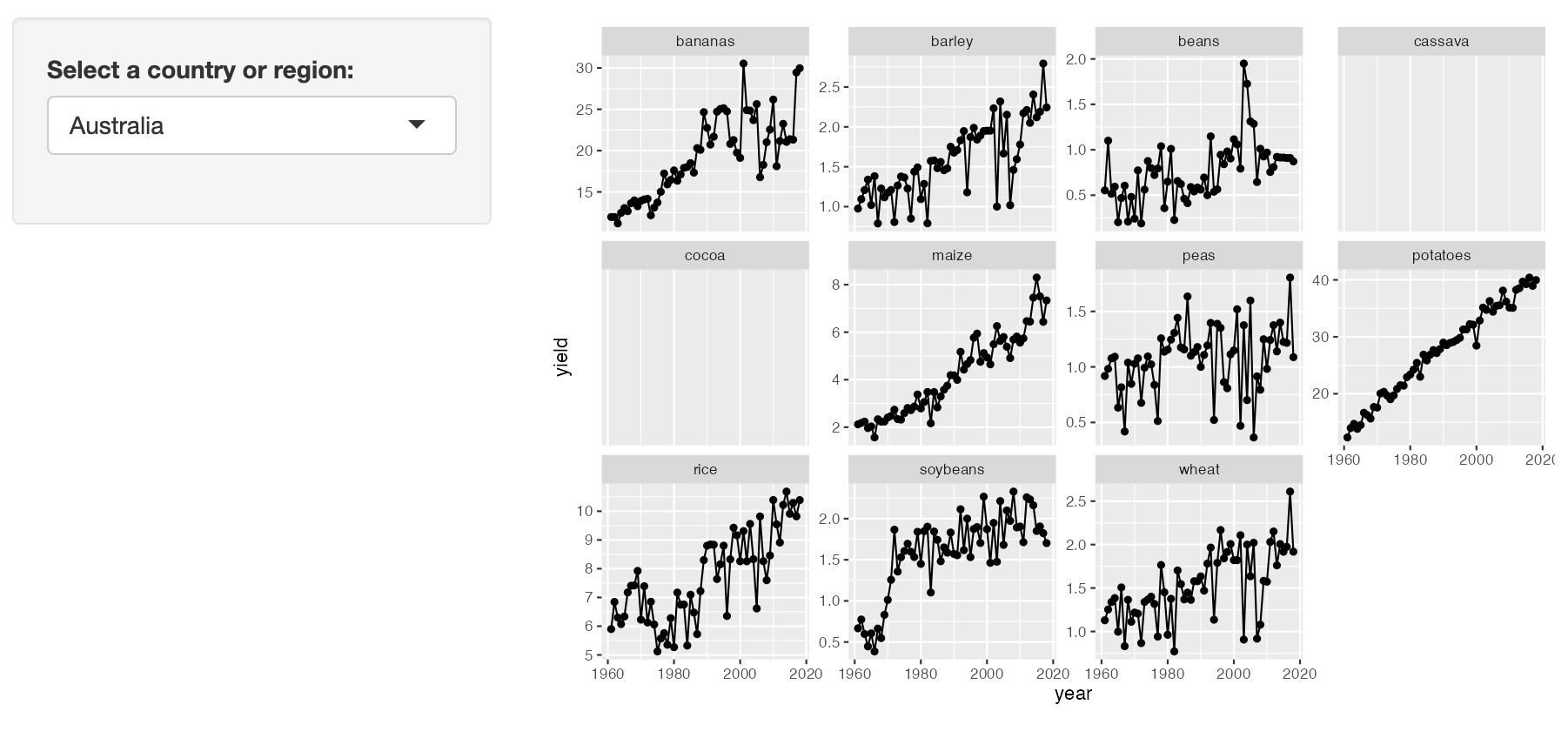ETC5523: Communicating with Data
Interactive
Lecturer: Emi Tanaka
Department of Econometrics and Business Statistics
Aim
- Gain exposure to existing state-of-the-art interactive graphics
- Understand the difference between interactivity in Shiny and say, Plotly graphics
User Interactions
Image from Spencer (2022, Feb. 17). Data in Wonderland. Retrieved from https://ssp3nc3r.github.io/data_in_wonderland
User Inputs
Image from Spencer (2022, Feb. 17). Data in Wonderland. Retrieved from https://ssp3nc3r.github.io/data_in_wonderland
Overview

Image from Spencer (2022, Feb. 17). Data in Wonderland. Retrieved from https://ssp3nc3r.github.io/data_in_wonderland
State of the art for
interactive plots
Interactive plots with JS
- State-of-the-art for interactive plots is JS
- Some of the most popular and free JS library for plotting are:
- Rising JS libraries that are based on the Grammar of Graphics:
Interactive plots with JS through R
- No need to learn JS!
- Many JS library for plotting are available via an R package:
Plotly
Plotly
- Plotly is a high-level, declarative library for plotting build on
d3.jsandstack.gl(open software ecosystem for WebGL).
Plotly for ggplot2
Plotly with drop down menu
Code for Plotly with drop down menu
yields <- na.omit(cwdata::key_crop_yields)
crops <- sort(unique(yields$crop))
map(crops, ~ {
yields %>%
filter(crop == .x) %>%
plot_ly(
x = ~ year,
y = ~ yield,
type = 'scatter',
mode = 'lines',
color = ~ crop,
transforms = list(
list(
type = 'filter',
target = ~ entity,
operation = '=',
value = "Afghanistan"
)
)
)
}) %>%
subplot(nrows = 3) %>%
layout(
showlegend = FALSE,
annotations = imap(crops, ~ {
list(
x = 0 + 1 / 4 * (.y - 1) - 1 / 4 * 4 * (.y > 4) - 1 / 4 * 4 * (.y > 8),
y = 1 - 0.05 - 1 / 3 * (.y > 4) - 1 / 3 * (.y > 8) ,
font = list(size = 18),
text = .x,
xref = "paper",
yref = "paper",
xanchor = "center",
yanchor = "bottom",
showarrow = FALSE
)
}),
updatemenus = list(list(
type = 'dropdown',
active = 0,
buttons = map(
unique(yields$entity),
~ list(
method = "restyle",
args = list("transforms[0].value", .x),
label = .x
)
)
))
)Difference to Shiny

Code for Shiny app
library(shiny)
library(ggplot2)
library(dplyr)
library(cwdata)
ui <- fluidPage(
br(),
sidebarLayout(
sidebarPanel(
selectizeInput("entity",
"Select a country or region:",
choices = sort(unique(key_crop_yields$entity)),
selected = "Australia")
),
mainPanel(
plotOutput("tsplot")
)
)
)
server <- function(input, output, session) {
output$tsplot <- renderPlot({
key_crop_yields %>%
filter(entity == input$entity) %>%
ggplot(aes(year, yield)) +
geom_line() +
geom_point() +
facet_wrap(~crop, scale = "free_y")
})
}
shinyApp(ui, server)Week 12 Lesson
Summary
- State of the art in interactive visualisation uses JS
- Many of the well known JS is available through an R package
- Shiny requires a server backend to run R
- Interactive plots produced by R packages generally do not need a server but are often limited in scope with the prescribed interactivity
Resources
Sievert (2019) Interactive web-based data visualization with R, plotly, and shiny
Shneiderman (2003) The Eyes Have It: A Task by Data Type Taxonomy for Information Visualizations. The Craft of Information Visualization: Readings and Reflections

ETC5523 Week 12